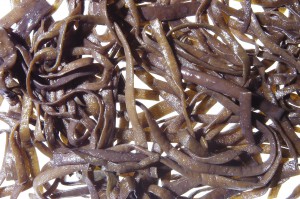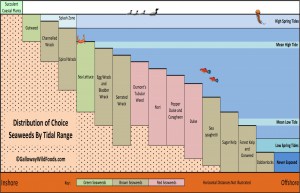Sea spaghetti – Identification, Edibility, Distribution
Himanthalia elongata, AKA Thongweed
Habitat: Lower rocky shores, especially in semi-exposed locations
Identification: Hard to mistake – up to 2m long yellowy brown spaghetti-like fronds, dividing near the base, growing from small, button-like holdfasts.
Edible Uses: Young fronds are good raw or pickled in salads. Once they get longer than about 20cm, they are best cooked. Full grown, they can be a little tough. As the name suggests, you can treat them like spaghetti.
Harvest: Best in spring and summer, becoming gradually tougher. Be sure to leave the perennial button-like holdfast intact to regrow.
Similar species: Mermaid’s tresses (Chorda filum) also has a spaghetti-like growth habit. It lacks the discoid holdfast of sea spaghetti, and tends to attach to rock and pebbles in sheltered shallow water, often harbours and marinas. Its holdfasts are seldom exposed, even at low spring tides. When picked from clean water it is edible and good, with a crunchier texture than sea spaghetti.
Related pages:
For in-depth exploration on all aspects of seaweed, check out my Seaweed Webinar.
“The webinar was amazing! You are a good storyteller. Scientific information, combined with tips and beautiful picturing. 👏” – Kanlenaki on Instagram
“This was absolutely brilliant, thank you so very much for being so generous with your knowledge! The webinar format of videos and live worked fantastically!” – Sarah Hobbs, Webinar chat comments



1 Comment
Great page ! Iv always loved seaweed but never foraged it except sea lettuce so all the info is greatly appreciated